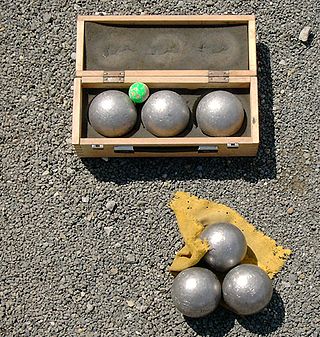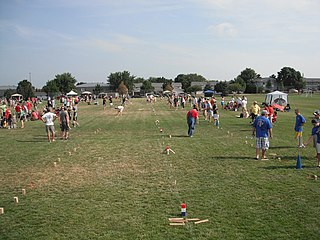
Bocce, sometimes anglicized as bocce ball, bocci, or boccie, is a ball sport belonging to the boules family. Developed into its present form in Italy, it is closely related to British bowls and French pétanque, with a common ancestry from ancient games played in the Roman Empire. Bocce is played around Western, Southern, and Southeastern Europe, as well as in overseas areas with historical Italian immigrant population, including Australia, North America, and South America, principally Argentina and the southern Brazilian states of Rio Grande do Sul and Santa Catarina. Initially it was only played by the Italian immigrants, the game has slowly become more popular among their descendants and more people around the world.

Boules, or jeu de boules, is a collective name for a wide range of games similar to bowls and bocce in which the objective is to throw or roll heavy balls as closely as possible to a small target ball, called the jack. 'Boules' itself is a French loanword that usually refers to the game especially played in France.

Kubb is a lawn game where the objective is to knock over wooden blocks by throwing wooden batons at them. Kubb can be described as a combination of bowling and horseshoes. Play takes place on a small rectangular playing field, known as a "pitch". "Kubbs" are placed at both ends of the pitch, and the "king", a larger wooden block, is placed in the middle of the pitch. Some rules vary from country to country and from region to region, but the ultimate objective of the game is to knock over the "kubbs" on the opposing side of the pitch, and then to knock over the "king", before the opponent does. Games can last from five minutes to well over an hour. The game can be played on a variety of surfaces such as grass, sand, concrete, snow, or even ice.

Five-pin bowling is a bowling variant which is played in Canada, where many bowling alleys offer it, either alone or in combination with ten-pin bowling. It was devised around 1909 by Thomas F. Ryan in Toronto, Ontario, at his Toronto Bowling Club, in response to customers who complained that the ten-pin game was too strenuous. He cut five tenpins down to about 75% of their size, and used hand-sized hard rubber balls, thus inventing the original version of five-pin bowling.

Skittles is a historical lawn game and target sport of European origin, from which the modern sport of nine-pin bowling is descended. In regions of the United Kingdom and Ireland the game remains as a popular indoor pub game.

Candlepin bowling is a variation of bowling that is played primarily in the Canadian Maritime provinces and the New England region of the United States. It is played with a handheld-sized ball and tall, narrow pins that resemble candles, hence the name.

Table skittles is a game in which a ball or spinning top is used to knock over skittles on a small board, usually placed on a table. Table skittles are almost always made of wood.

Basque rural sports, known as Deportes Rurales in Spanish or Herri Kirolak in Basque, is the term used for a number of sports competitions rooted in the traditional lifestyles of the Basque people. The term force basque is used in French.

The Cantabria autonomous football team is the regional football team for Cantabria, Spain. They are not affiliated with FIFA or UEFA and therefore are only allowed to play friendly matches.

Five-pin billiards or simply five-pins or 5-pins, is today usually a carom billiards form of cue sport, though sometimes still played on a pocket table. In addition to the customary three balls of most carom games, it makes use of a set of five upright pins (skittles) arranged in a "+" pattern at the center of the table. The game is popular especially in Italy and Argentina, but also in some other parts of Latin America and Europe, with international, televised professional tournaments. It is sometimes referred to as Italian five-pins or Italian billiards, or as simply italiana. A variant of the game, goriziana or nine-pins, adds additional skittles to the formation. A related pocket game, with larger pins, is played in Scandinavia and is referred to in English as Danish pin billiards, with a Swedish variant that has some rules more similar to the Italian game.

Basque bowls, is one of the few Basque rural sports which do not originate in an activity related to rural or marine work. It has a number of other names too and is played in a bolatoki or bolaleku "bowls place" which often consists of a playing area in the open, an open sided structure with a low roof or a playing area located inside a colonnaded hallway.

Nine-pin bowling is a bowling game played primarily in Europe. European championships are held each year. In Europe overall, there are some 130,000 players. Nine-pin bowling lanes are mostly found in Austria, Czech Republic, Slovakia, Belgium, Germany, Luxembourg, the Netherlands, Estonia, Switzerland, Serbia, Slovenia, Croatia, Poland, North Macedonia, Hungary, France, Brazil and Liechtenstein.

Goriziana or nine-pin billiards is a carom billiards game, especially popular in Italy.

Danish billiards or keglebillard, sometimes called Danish five-pin billiards, is the traditional cue sport of Denmark, and the game remains predominantly played in that country. It makes use of a 5 × 10 ft six-pocket table, three billiard balls, and five pins, which are considerably larger than those used in the similar and internationally standardized game of five-pin billiards.

The origins of bowling in Spain are uncertain, but legend says that over a thousand years ago, at the time of the primitive Castile, the Highlanders bet their weapons and even the horses that used to fight the Arabs in contested and passionate bowls matches. It is even said that the warring Cantabrians that inhabited the north of Spain challenged each other in bowling matches before frighten the imperial legions of Augustus.

Throwing sports, or throwing games, are physical, human competitions where the outcome is measured by a player's ability to throw an object.

The Asturian bowling is the variation of bowling mainly played in Asturias, and the most important traditional sport in this Spanish Autonomous Community.
















